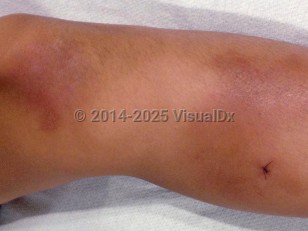Hyperimmunoglobulinemia D syndrome
Synopsis

HIDS typically presents in infancy with a median age of onset of 6 months. The primary manifestation of HIDS is recurrent febrile attacks occurring at varied intervals with duration of 3-7 days. Frequent triggers of febrile attacks include vaccinations, illness, and emotional stress. The attacks may begin with a prodrome of headache and malaise followed by the onset of a high fever, often 40°C (104°F) or higher. Patients may also experience tender cervical lymphadenopathy, abdominal pain, diarrhea, vomiting, arthralgias or nonerosive arthritis, splenomegaly, oral ulcers (in up to a half of patients) or genital ulcers, and pharyngitis. Cutaneous manifestations are observed in about 70% of patients with HIDS; however, skin findings do not necessarily occur with every febrile attack. The skin findings include erythema nodosum, vasculitis, urticarial lesions, and a morbilliform eruption.
Although a few cases of associated amyloidosis have been reported, amyloidosis is not typically seen with HIDS.
Note: It is rare for symptoms to first manifest in those older than 5 years, so other periodic fever syndromes should be considered first in such cases.
Codes
D82.8 – Immunodeficiency associated with other specified major defects
SNOMEDCT:
403834003 – Hyper-immunoglobulin D periodic fever syndrome
Look For
Subscription Required
Diagnostic Pearls
Subscription Required
Differential Diagnosis & Pitfalls

Subscription Required
Best Tests
Subscription Required
Management Pearls
Subscription Required
Therapy
Subscription Required
References
Subscription Required
Last Updated:12/27/2022

